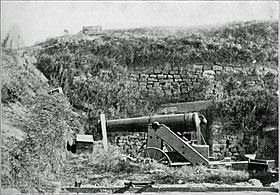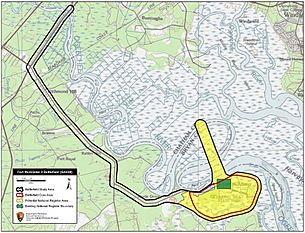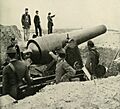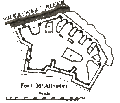Battle of Fort McAllister (1864) facts for kids
Quick facts for kids Battle of Fort McAllister |
|||||||
|---|---|---|---|---|---|---|---|
| Part of the American Civil War | |||||||
 A heavy gun in Fort McAllister |
|||||||
|
|||||||
| Belligerents | |||||||
| Commanders and leaders | |||||||
| William B. Hazen | George Wayne Anderson | ||||||
| Units involved | |||||||
| 2nd Division, XV Corps, Army of the Tennessee | Fort McAllister Garrison Emmett Rifles Clinch's Light Battery 1st Regiment, Georgia Reserves |
||||||
| Strength | |||||||
| 4,000 | 120 250 | ||||||
| Casualties and losses | |||||||
| 134 | 71 | ||||||
The Battle of Fort McAllister happened on December 13, 1864. It was a key moment during the final part of General William T. Sherman's famous Sherman's March to the Sea. During this march, Union soldiers traveled through Georgia.
In this battle, the Union forces attacked a small group of Confederate soldiers. These soldiers were defending Fort McAllister. This fort was very important because it was near Savannah, Georgia. Capturing it was a big goal for the Union army.
Why Fort McAllister Was Important
As General Sherman's armies got close to Savannah in December 1864, they needed supplies. They had been marching for a long time from Atlanta. Off the coast, a Union fleet led by Admiral John A. Dahlgren was waiting. This fleet had the supplies and mail that Sherman's soldiers needed.
However, Confederate defenses around Savannah stopped the fleet from reaching Sherman. Sherman's cavalry, which are soldiers on horseback, explored the area. They found that Fort McAllister was not very well defended. They believed it could be captured by a strong attack.
Sherman knew that if his army took Fort McAllister, they would control the Ogeechee River. This river would give them a clear path to the sea. This path would allow them to get the supplies from Admiral Dahlgren's ships. So, Sherman ordered Major General Oliver O. Howard's army to capture the fort. Howard chose Brigadier General William B. Hazen's division to lead the attack.
The Attack on the Fort
On December 13, 1864, General Hazen's division, with about 4,000 soldiers, got ready to attack Fort McAllister. General Sherman and General Howard watched the battle from a high platform. This platform was built on top of an old rice mill.
Hazen's soldiers moved through the nearby woods. They spread out widely to make it harder for the fort's cannons to hit them. The fort was defended by about 230 experienced Confederate soldiers. Their commander was Major George Wayne Anderson.
As the sun began to set, a Union Navy ship called the USS Dandelion appeared. Sherman signaled to the ship that the fort was still held by the enemy. But he also signaled that it would be theirs very soon. Just then, Hazen's men burst out of the woods. They charged towards the fort.
The Union soldiers had to get through obstacles like sharpened stakes (called abatis) and hidden explosives (called torpedoes or land mines). They quickly reached the fort's walls and overpowered the defenders. The fort fell in just 15 minutes.
After the Battle
General Sherman was very happy about the victory. He rowed down the Ogeechee River to see the fort himself. That evening, at a place called Lebanon Plantation, Sherman and Hazen had supper with Major Anderson. This plantation was Anderson's childhood home and was now Hazen's headquarters.
During their meal, General Sherman was upset that Major Anderson had used land mines around the fort. He felt it was not a fair way to fight. Sherman ordered Major Anderson to help clear these mines after the battle. Before being held captive, Major Anderson even helped some Union soldiers avoid stepping on hidden mines. He led them away from danger.
The day after the battle, Sherman met with Admiral Dahlgren on his ship. Sherman was also proud of the soldiers who captured Fort McAllister. These were the same troops he had commanded in earlier battles like Shiloh and the Siege of Vicksburg.
With Fort McAllister captured, Sherman's army now had an open supply line. This allowed him to get ready to attack and capture Savannah. He achieved this goal by Christmas.
Images for kids










